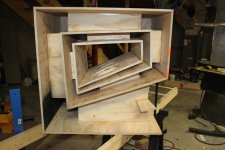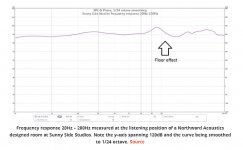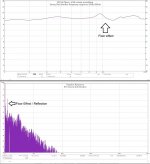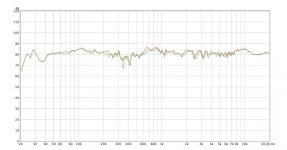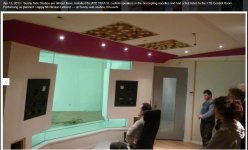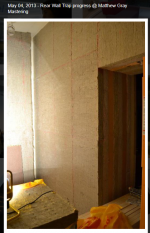Flat to 30Hz comes with numerous limitations.
You either want to use a separate, preferably horn loaded, bass solution, or, in case of a 2 way, cross below 500 Hz.
You either want to use a separate, preferably horn loaded, bass solution, or, in case of a 2 way, cross below 500 Hz.
Horn loading comes its own set of problems...I wonder why Bills horn designs do not have slot cancellation issues, now that I think about it...a flare does not fix that....I don't think...I modeled an extension of the ~930cm2 slot into a horn with no flare...it works...but phase pattern flip rendered it useless without using linear phase...i attributed that to the lack of a flare...
My thought was that the rear chamber should maintain the 0.5qts standard and the horn was tuned to 30hz... Bills design start with a very small csa...so I guess that gets rid of the slot cancellation....He claims that large woofer diaphragms are not rigid enough to withstand pressure at the start of his horns...how true that is, I don't know...the more I think about it, the less sense it makes....Csa can be increased but focusing on his builds with the tiny starting csa....a large woofer moves less...so I dunno....a PPSL is great way to start a bass horn...technically it is a 4th order bandpass with an extremely truncated horn
My thought was that the rear chamber should maintain the 0.5qts standard and the horn was tuned to 30hz... Bills design start with a very small csa...so I guess that gets rid of the slot cancellation....He claims that large woofer diaphragms are not rigid enough to withstand pressure at the start of his horns...how true that is, I don't know...the more I think about it, the less sense it makes....Csa can be increased but focusing on his builds with the tiny starting csa....a large woofer moves less...so I dunno....a PPSL is great way to start a bass horn...technically it is a 4th order bandpass with an extremely truncated horn
My thought was that the rear chamber should maintain the 0.5qts standard and the horn was tuned to 30hz... ....He claims that large woofer diaphragms are not rigid enough to withstand pressure at the start of his horns...
It's very true of all but the stiffest diaphragms and especially the suspension if the compression chamber doesn't null it out, IOW 'lock' it in place to perform as a solid piston in a bore, i.e. an electric solenoid, which is the analog of driver design, hence traditional compression horn design in general is an under-damped driver 'cycling' an over-damped bore with 0.5 sysQ the theoretical ideal goal.
As usual you are pushing my envelope...
I accidently said qts when I meant Qtc....I have no idea how to view Q with the horn in front. But I figured that at least one would start with a Qtc of 0.5 with the rear chamber. From there, imitating Bills horns...an offset driver at the very start of the horn, with a rather small CSA that expands and wraps around like a snail shell, till the finish....
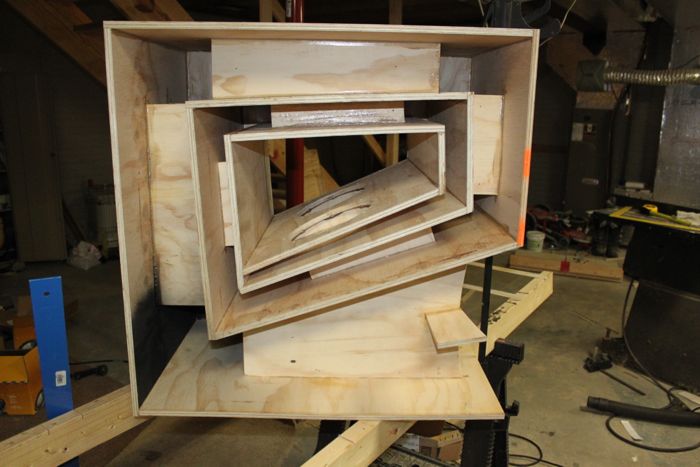
Finally it is sinking in what you've said GM....I wouldn't have a clue how to judge diaphragm stiffness...I know its a thing...actually a thing I've brought up several times in this thread and no one comments on it. I know that if a drivers diaphragm is not stiff enough it will bend with enough resistance due to excursion and high power and cause distortion. We never talked about or even acknowledged that once in this thread and I thought it was weird.
How to predict if a woofers diaphragm was rigid enough...no idea...not that I am doubting AE's, but in the terms of if a 18H+ could perform in a horn starting out with a small CSA... I don't think its predictable..
I accidently said qts when I meant Qtc....I have no idea how to view Q with the horn in front. But I figured that at least one would start with a Qtc of 0.5 with the rear chamber. From there, imitating Bills horns...an offset driver at the very start of the horn, with a rather small CSA that expands and wraps around like a snail shell, till the finish....
Finally it is sinking in what you've said GM....I wouldn't have a clue how to judge diaphragm stiffness...I know its a thing...actually a thing I've brought up several times in this thread and no one comments on it. I know that if a drivers diaphragm is not stiff enough it will bend with enough resistance due to excursion and high power and cause distortion. We never talked about or even acknowledged that once in this thread and I thought it was weird.
How to predict if a woofers diaphragm was rigid enough...no idea...not that I am doubting AE's, but in the terms of if a 18H+ could perform in a horn starting out with a small CSA... I don't think its predictable..
Attachments
As to your system being down -6db at 30hz...that isn't acceptable for mastering...so the question is, with the system voiced flat to 30hz...how loud could you play before distortion became an issue...
What cutoff frequency do you need fo rmastering and does it have to reach the same levels down low as it has for >40 Hz ?
Since the tuning on mine is around 30 Hz there is some marging to turn it up a little there. I have also experimented with 6th order tunings to reach a little lower. But I don't like it that much and I feel it is due to the steeper drop-off.
Regards
Charles
Diaphragm stiffness is one thing, quite a big thing I would say, and so is compliance, of both suspension and the "system".
At very low frequencies we mainly deal with radiation resistance > coupling of acoustic output to air, which entails several challenges and trade-offs.
As always, system efficiency (η) is also an important factor.
The horn shown in the previous post is Bill Fitzmaurice's Table Tuba for which the recommended T/S parameters are: Fs 28 to 40Hz, Qts .30 to .50, Vas 15 to 45L, Xmax 8mm or more.
Compare the parameters of the driver that Bjørn Kolbrek used for his first bass horn (attached).
Xmax is the antonym of η.
Further reading:
At very low frequencies we mainly deal with radiation resistance > coupling of acoustic output to air, which entails several challenges and trade-offs.
As always, system efficiency (η) is also an important factor.
The horn shown in the previous post is Bill Fitzmaurice's Table Tuba for which the recommended T/S parameters are: Fs 28 to 40Hz, Qts .30 to .50, Vas 15 to 45L, Xmax 8mm or more.
Compare the parameters of the driver that Bjørn Kolbrek used for his first bass horn (attached).
Xmax is the antonym of η.
Further reading:
Attachments
-
 Sammi SR-12A300.jpg309.6 KB · Views: 290
Sammi SR-12A300.jpg309.6 KB · Views: 290 -
AES-Jubilee_A Revised Low-Frequency Horn of Small Dimensions. ROY DELGADO, JR. and PAUL W. KLIPS.pdf923.5 KB · Views: 128
-
On the Specification of Moving-Coil Drivers for Low-Frequency Horn-Loaded Loudspeakers (Leach, W.pdf971.3 KB · Views: 83
-
Keele LF_Horn_Design_Using_TS[1].pdf683.4 KB · Views: 210
-
Problems of Low Frequency Reproduction by Saul J. White.pdf275.3 KB · Views: 119
Last edited:
Many among us are familiar with the research of Klippel and others on modern driver technology. However, we often tend to forget that "size" and SPL have become major design factors in the development of loudspeaker drivers. Today we have high Xmax, shorting rings and very high output (power) ratings, but do these inventions result in better sound?
In another forum, someone compared modern woofers to antique ones.
The results were quite astonishing.
"One of the key elements that make this old Electrovoice speaker surpass a lot of modern day speakers is the midrange within the 500 Hz – 2 kHz range.
The majority of modern day speakers have great difficulty keeping a level plane from 1 kHz – 2 kHz. They simply offer a sharp momentary rise or dip which brings forth a jagged response at audible levels. Frequencies ranging from 1 kHz to 2 kHz are the most complex part of the midrange section and the most influential part in the midrange performance.
From a 1953 catalogue Electrovoice states the loudspeaker offers a resonance of 72 Hz in which, LIMP measured an fs of 76.8 Hertz. Since the fs are higher than the manufactures claim, it means the cone suspension is still stiff. If the fs were to fall below 72 Hz, such reduction in the fs would mean the driver experienced a lot of Bass notes.
The person I purchased the loudspeakers from claimed his parents used them to listen to music. I would imagine the loudspeakers had a very easy life, for I noticed spider webs moving from the rear of the cone to the tinsel followed by the spider suspension.
I have not calculated all the TS Parameters, however the QTS is 0.25 with an fs of 76.8.
The manufacture specifications are the following:
1 pound Alnico Magnet
1 ½ inch voice coil
40 Hz – 12,000 kHz
Resonance: 72 Hz
These 1952 Electrovoice Speakers are by far the best sounding speakers I have at the moment for midrange when compared to the RCF L10L750YK, Electro-Voice FORCE 10, Eminence Beta 10 CBMRA, FANE Studio 12L, FANE Classic 12/150 in addition to the Electrovoice EVM 15B.
Here is a video with the Electrovoice 8-inch, RCF 10-inch, & FANE 12-inch Loudspeakers playing Reggae. I designed a quick semi-horn (275 Hz Half Space) for the Electrovoice speakers just hear how they would sound in a box. With a measured QTS of 0.25 it would be ridiculous to put these speakers in a reflex box. The High Pass Filter for the Electrovoice 8-inch are 140 Hz (12 dB per octave) with the RCF 10-inch and, FANE 12-inch receiving a HPF of 100 Hz (12 dB per octave). The RCF & FANE are loaded in straight horns as well."
The recording was made using an Earthworks M 50 Microphone, a very old Wamirack 192X 10 Channel 192 kHz audio interface and, Samplitude version 11.
In another forum, someone compared modern woofers to antique ones.
The results were quite astonishing.
"One of the key elements that make this old Electrovoice speaker surpass a lot of modern day speakers is the midrange within the 500 Hz – 2 kHz range.
The majority of modern day speakers have great difficulty keeping a level plane from 1 kHz – 2 kHz. They simply offer a sharp momentary rise or dip which brings forth a jagged response at audible levels. Frequencies ranging from 1 kHz to 2 kHz are the most complex part of the midrange section and the most influential part in the midrange performance.
From a 1953 catalogue Electrovoice states the loudspeaker offers a resonance of 72 Hz in which, LIMP measured an fs of 76.8 Hertz. Since the fs are higher than the manufactures claim, it means the cone suspension is still stiff. If the fs were to fall below 72 Hz, such reduction in the fs would mean the driver experienced a lot of Bass notes.
The person I purchased the loudspeakers from claimed his parents used them to listen to music. I would imagine the loudspeakers had a very easy life, for I noticed spider webs moving from the rear of the cone to the tinsel followed by the spider suspension.
I have not calculated all the TS Parameters, however the QTS is 0.25 with an fs of 76.8.
The manufacture specifications are the following:
1 pound Alnico Magnet
1 ½ inch voice coil
40 Hz – 12,000 kHz
Resonance: 72 Hz
These 1952 Electrovoice Speakers are by far the best sounding speakers I have at the moment for midrange when compared to the RCF L10L750YK, Electro-Voice FORCE 10, Eminence Beta 10 CBMRA, FANE Studio 12L, FANE Classic 12/150 in addition to the Electrovoice EVM 15B.
Here is a video with the Electrovoice 8-inch, RCF 10-inch, & FANE 12-inch Loudspeakers playing Reggae. I designed a quick semi-horn (275 Hz Half Space) for the Electrovoice speakers just hear how they would sound in a box. With a measured QTS of 0.25 it would be ridiculous to put these speakers in a reflex box. The High Pass Filter for the Electrovoice 8-inch are 140 Hz (12 dB per octave) with the RCF 10-inch and, FANE 12-inch receiving a HPF of 100 Hz (12 dB per octave). The RCF & FANE are loaded in straight horns as well."
The recording was made using an Earthworks M 50 Microphone, a very old Wamirack 192X 10 Channel 192 kHz audio interface and, Samplitude version 11.
Last edited:
In view of diaphragm stiffness and compliance of the suspensions parts, a Japanese compared an Altec 515-8LF (Red) with the Sony SUP-L11 (Blue).
The frequency response was measured for 16-inch woofers from SONY and ALTEC. Both are 8 Ohm Alnico woofers.
Image 1. Sine sweep 20-20KHz.
I also compared the sine wave response of a single frequency.
The Altec (red) has a higher low frequency level, this is probably due to the influence of the room.
2. 100Hz sine wave
Blue has more noise than the 100Hz signal as a whole. At a 100Hz signal peak, it is almost the same for blue -41.4dB compared to red -41.7dB. However, except for the harmonic distortion at 200Hz (2nd order) and 300Hz (3rd order), the distortion of blue is on a whole higher than 15dB.
3. 200Hz sine wave
Again, there is a 20 dB distortion difference between red -27.2 dB, and blue -32.3 dB signal. Considering the signal, there is a total difference of 25 dB or more in distortion.
4. 400Hz sine wave
At this frequency, the response signal peak level is reversed to red -42.4dB and blue -32.0dB. Since the distortion level is about 10 dB different, it can be said that the total distortion level is almost the same. However, it seems that the number of higher-order distortion peaks of harmonic distortion (divided vibration) is clearly higher for the Altec (red).
5. 500Hz sine wave
Here, red and blue have almost the same frequency response and distortion level. After all, red has a larger amount amount of higher-order distortion.
6. 630Hz sine wave
At the crossover, red is -49.8dB and blue is -54.7dB. This frequency is covered by the the horn driver, so I would like the woofer to be as quiet as possible. Again, blue has more distortion.
7. This is the spectrum of the second-order distortion at 500Hz input.
Regarding the 1kHz second order distortion, both are almost the same level: red -91.8dB and blue -93.3dB.
8. This is the spectrum of the third-order distortion at 500Hz input.
The third-order distortion at 1.5kHz was significantly different from red -71.8dB and blue -89dB. The 5th order distortion at 2.5kHz is also very different.
It is generally said that odd-order harmonic distortion adversely affects sound quality, so care must be taken.
Summary:
From the above, the noise floor of red is lower than that of blue. Especially in the low frequency range of 200Hz or less, the result shows that there is little distortion of 20dB or more. Harmonic distortion of the Altec (red) is clearly higher for odd orders. At 200Hz, the red peak and the blue noise floor distortion are at the same level. At 400Hz, the difference between the red and blue third-order distortion is clear.
Since the input level was relatively small and was 0.4W or less, it may have been difficult to attribute differences to the long voice coil (Sony) and the short voice coil.
It is remarkable that the 515-8LF sounds overwhelmingly low distortion when producing a pure tone like a sine wave.
By the way, woofers that use cones made of materials other than paper have overcome this problem with strong reinforced diaphragms. I think decentralized paper is now rather a minority. Unfortunately, with a reinforced diaphragm, you have to put up with a sound like an AV subwoofer that has too much mass to stand up and tighten. Compared to this, paper is still better.
The frequency response was measured for 16-inch woofers from SONY and ALTEC. Both are 8 Ohm Alnico woofers.
Image 1. Sine sweep 20-20KHz.
I also compared the sine wave response of a single frequency.
The Altec (red) has a higher low frequency level, this is probably due to the influence of the room.
2. 100Hz sine wave
Blue has more noise than the 100Hz signal as a whole. At a 100Hz signal peak, it is almost the same for blue -41.4dB compared to red -41.7dB. However, except for the harmonic distortion at 200Hz (2nd order) and 300Hz (3rd order), the distortion of blue is on a whole higher than 15dB.
3. 200Hz sine wave
Again, there is a 20 dB distortion difference between red -27.2 dB, and blue -32.3 dB signal. Considering the signal, there is a total difference of 25 dB or more in distortion.
4. 400Hz sine wave
At this frequency, the response signal peak level is reversed to red -42.4dB and blue -32.0dB. Since the distortion level is about 10 dB different, it can be said that the total distortion level is almost the same. However, it seems that the number of higher-order distortion peaks of harmonic distortion (divided vibration) is clearly higher for the Altec (red).
5. 500Hz sine wave
Here, red and blue have almost the same frequency response and distortion level. After all, red has a larger amount amount of higher-order distortion.
6. 630Hz sine wave
At the crossover, red is -49.8dB and blue is -54.7dB. This frequency is covered by the the horn driver, so I would like the woofer to be as quiet as possible. Again, blue has more distortion.
7. This is the spectrum of the second-order distortion at 500Hz input.
Regarding the 1kHz second order distortion, both are almost the same level: red -91.8dB and blue -93.3dB.
8. This is the spectrum of the third-order distortion at 500Hz input.
The third-order distortion at 1.5kHz was significantly different from red -71.8dB and blue -89dB. The 5th order distortion at 2.5kHz is also very different.
It is generally said that odd-order harmonic distortion adversely affects sound quality, so care must be taken.
Summary:
From the above, the noise floor of red is lower than that of blue. Especially in the low frequency range of 200Hz or less, the result shows that there is little distortion of 20dB or more. Harmonic distortion of the Altec (red) is clearly higher for odd orders. At 200Hz, the red peak and the blue noise floor distortion are at the same level. At 400Hz, the difference between the red and blue third-order distortion is clear.
Since the input level was relatively small and was 0.4W or less, it may have been difficult to attribute differences to the long voice coil (Sony) and the short voice coil.
It is remarkable that the 515-8LF sounds overwhelmingly low distortion when producing a pure tone like a sine wave.
By the way, woofers that use cones made of materials other than paper have overcome this problem with strong reinforced diaphragms. I think decentralized paper is now rather a minority. Unfortunately, with a reinforced diaphragm, you have to put up with a sound like an AV subwoofer that has too much mass to stand up and tighten. Compared to this, paper is still better.
Attachments
-
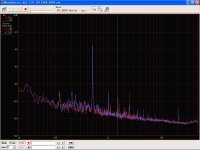 spectrum of the third-order distortion at 500Hz input.jpg334.3 KB · Views: 76
spectrum of the third-order distortion at 500Hz input.jpg334.3 KB · Views: 76 -
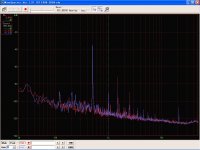 spectrum of the second-order distortion at 500Hz input.jpg330.4 KB · Views: 78
spectrum of the second-order distortion at 500Hz input.jpg330.4 KB · Views: 78 -
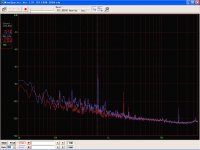 sine wave 630Hz.jpg335.6 KB · Views: 83
sine wave 630Hz.jpg335.6 KB · Views: 83 -
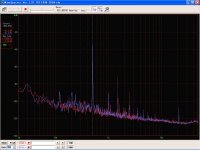 sine wave 500Hz.jpg332.4 KB · Views: 82
sine wave 500Hz.jpg332.4 KB · Views: 82 -
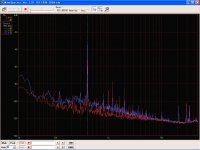 sine wave 400Hz.jpg336 KB · Views: 86
sine wave 400Hz.jpg336 KB · Views: 86 -
 sine wave 200Hz.jpg342.8 KB · Views: 101
sine wave 200Hz.jpg342.8 KB · Views: 101 -
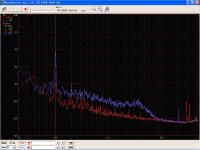 sine wave 100Hz.jpg339.5 KB · Views: 269
sine wave 100Hz.jpg339.5 KB · Views: 269 -
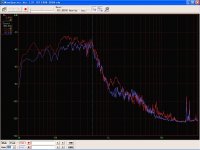 Sine Sweep at 20-20KHz.jpg334.9 KB · Views: 260
Sine Sweep at 20-20KHz.jpg334.9 KB · Views: 260
What cutoff frequency do you need fo rmastering and does it have to reach the same levels down low as it has for >40 Hz ?
Curious also as 'flat' to me and at least one recording studio from way back when is 'flat' to the ear, so taken to the normal 20 Hz lower limit this means +10 dB referenced to 1 kHz, ergo the room could play a significant role.
ergo the room could play a significant role.
At these frequencies the room (assuming a small room) plays a dominate role, making things like "flat" and woofer HP frequency and Q rather insignificant concepts in this regard.
If you don't want to call it flat, call it uncolored or neutral I guess...
Flat to 30hz is the standard for music
Flat to 20hz is likely the standard for Cinema
And then of course everything in between
I've always said that Big money is the only ones getting good neutral subbass in a room considered the challenges...
Becareful not to mix pink noise with white noise....the playback system is tuned flat to white noise...the mix is neutral in the respect of pink noise.
Maybe saying the word flat is to unnerving...can I say linear? basically smooth is really the idea...a flat line is smooth btw....even if unoptanium (expect for maybe headphones)...its just an idea I guess...I wonder what the house curve in a top cinema mastering studio looks like. I have a list of top studio house curves somewhere. The curves have names...
I'll have to dig some more but....but for mastering....+/-0db is the holy grail (to 30hz for most music and to 20hz for cinema like I said)
The mix has its own curve that relates more to the equal loudness curve depending on creative direction. Which also is related to pink noise as to how we hear sound as being equally balanced. The idea is that the playback system isn't adding character...if possible
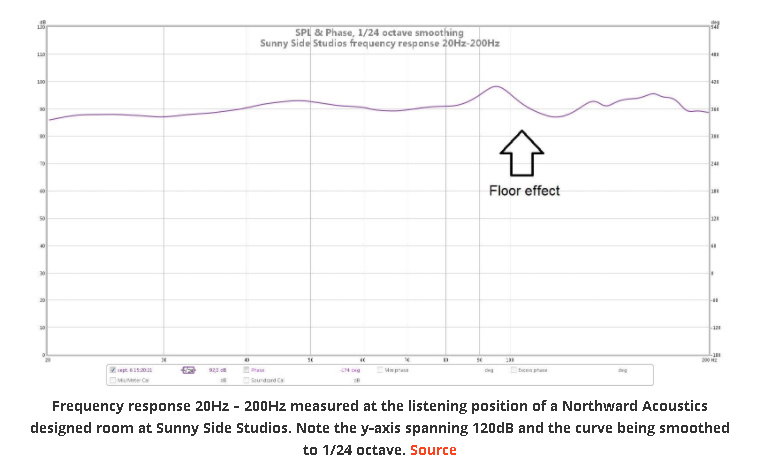
quotes from
An Inconvenient Truth About Room Acoustics (The Myth Of The Flat Frequency Response) — Acoustics Insider
Room's frequency response - Gearspace.com
Flat to 30hz is the standard for music
Flat to 20hz is likely the standard for Cinema
And then of course everything in between
I've always said that Big money is the only ones getting good neutral subbass in a room considered the challenges...
Becareful not to mix pink noise with white noise....the playback system is tuned flat to white noise...the mix is neutral in the respect of pink noise.
If you can't take the room out of your mix, you can't take your mix out of your room.
What is required is a SMOOTH response, i.e., no nulls or resonances (nulls are especially bad)
Maybe saying the word flat is to unnerving...can I say linear? basically smooth is really the idea...a flat line is smooth btw....even if unoptanium (expect for maybe headphones)...its just an idea I guess...I wonder what the house curve in a top cinema mastering studio looks like. I have a list of top studio house curves somewhere. The curves have names...
I'll have to dig some more but....but for mastering....+/-0db is the holy grail (to 30hz for most music and to 20hz for cinema like I said)
The mix has its own curve that relates more to the equal loudness curve depending on creative direction. Which also is related to pink noise as to how we hear sound as being equally balanced. The idea is that the playback system isn't adding character...if possible
slightly off topic but exactly my thinking towards building such a highly dynamic system and aiming towards as flat as possible from the initiative.I figure that if a speaker+room can do "flat" (within whatever error bars are acceptable) that the speaker+room can also be conservatively EQ'd to do any house curve that the user might desire.
Elephant in the room.In practice, getting a flat frequency response is pretty much impossible
Under optimal conditions, price not being the deciding factor, what can be achieved?
quotes from
An Inconvenient Truth About Room Acoustics (The Myth Of The Flat Frequency Response) — Acoustics Insider
Room's frequency response - Gearspace.com
Attachments
Last edited:
At these frequencies the room (assuming a small room) plays a dominate role
Indeed, especially nowadays due to an increasing desire for [extremely] well sealed buildings whereas my 'floating' floor house is basically a sieve, only showing significant gain down around 14 Hz and then only just long enough to shake it, causing ~1/3 of the ceiling beginning at the sound wall to come crashing down on us. 🙁
An Inconvenient Truth About Room Acoustics (The Myth Of The Flat Frequency Response) — Acoustics Insider
To get this quasi anechoic/free-field condition, where ALL the energy is absorbed as it travels down the room (hence front-to-back), Thomas layers different types of resonance (pressure) traps and porous (velocity) material around the entire room. There are absolutely no reflective surfaces left for the speakers to “see” apart from the floor. All the walls and ceiling make up a huge full spectrum absorber.
Sounds like a transmission line with wall dampening to me....
Heres a nice home mastering studio FR
THis is what I mean by flat to 30hz....I guess flat isn't implied as literal. Flat means the most neutral you can muster down to whatever....yet....If flat were possible....why not...might as well just call it flat. Its flat as possible and literal flat is unachievable. Ill say Flat as possible in the future to avoid confusion.
Attachments
Last edited:
Double the scale to 240 dB and it will look even flatter. Anyways, it's an anechoic chamber, not usually a good listening room.
There are different philosophies for mastering rooms...this is just one of many...but generally accepted, even by yourself I think, Is a FR that is smooth/linear in nature, house curves are personal preferences that do not deviate much from "flat" as in, flat as possible... I prefer a tilt with bass in favor...In regards to reverberation, as you say, the above is basically an anechoic chamber, I know of another approach that seeks to diffuse everything....in regards to the comment you made about an experience you had within a gymnasium where the time aspect was elongated and somehow turned into resolution...I think I would like something along the diffusion approach.
That doesn't look very nice or flat to me. Almost every speaker needs to have some tilt down from the bass to the treble to sound right with already recorded music. The amount depends on the speaker directivity and the room it is in. A cone and dome system in a fairly ordinary room (which is what many mastering rooms resemble) should have a tilt of somewhere around 1dB per octave from 100Hz or there about. A good speaker with flat on axis anechoic response and smooth off axis response will give this when put into a room.Heres a nice home mastering studio FR
This is not per se a room or house curve, it is just what a well measuring cone and dome speaker does all by it's self. A speaker with a flatter DI tends to have the on axis response designed to fall gently to compensate.
The 5dB bump at 600Hz will sound off and the similar bump at 8K will be quite sibilant. The treble being louder than the bass will make it sound bright. Flat anechoic and flat in room are not equivalent.
Yeah I dont know whats upwith those bumps but Id think/hope they could easily be corrected
A lot of you guyses (that have been apart of my journey and elongate conversation) rooms are at home mastering studio levels....so for you to criticize that FR is meritable...and somewhat sad considering that I've tried to share things I've learned here with the FB mastering group and get banned for being the crazy man trying to get them to learn loudspeaker engineering, which would only improve their studio kills...but whatevs.
Fluid what do you think of the sunny side FR and impulse response....This is just some random stuff I found in the heat of the moment to help paint the picture for Phase_accurate.
Once could potentially learn to sound engineer in a quasi anechoic room....or headphones....but I wonder why the challenge exactly...My first thought goes to room gain or room domination....I can mix/master in headphones ok...using wavesnx and hd600's...really its the headphones that are helping since waves nx barely has anything to equalize....then the room simulators I dunno....I haven't touched a mix since I started this journey of building mastering monitors....but I know so much more know thanks to this forum....I feel like Bass should probably be monitored in the far field to allow much room....but then the room has to be standardized....like the average American living room or the Average Club dance floor oir Average Cinema Theater...someone in the averages lys the happy medium for mastering, In my opinion. basically We needed to "dominate" the room aspect since the room dominates...removing the room is a broad sword approach.
A lot of you guyses (that have been apart of my journey and elongate conversation) rooms are at home mastering studio levels....so for you to criticize that FR is meritable...and somewhat sad considering that I've tried to share things I've learned here with the FB mastering group and get banned for being the crazy man trying to get them to learn loudspeaker engineering, which would only improve their studio kills...but whatevs.
Gm you are hilarious lol!!!only showing significant gain down around 14 Hz and then only just long enough to shake it, causing ~1/3 of the ceiling beginning at the sound wall to come crashing down on us.
Fluid what do you think of the sunny side FR and impulse response....This is just some random stuff I found in the heat of the moment to help paint the picture for Phase_accurate.
Once could potentially learn to sound engineer in a quasi anechoic room....or headphones....but I wonder why the challenge exactly...My first thought goes to room gain or room domination....I can mix/master in headphones ok...using wavesnx and hd600's...really its the headphones that are helping since waves nx barely has anything to equalize....then the room simulators I dunno....I haven't touched a mix since I started this journey of building mastering monitors....but I know so much more know thanks to this forum....I feel like Bass should probably be monitored in the far field to allow much room....but then the room has to be standardized....like the average American living room or the Average Club dance floor oir Average Cinema Theater...someone in the averages lys the happy medium for mastering, In my opinion. basically We needed to "dominate" the room aspect since the room dominates...removing the room is a broad sword approach.
Last edited:
It's a Jounjean room designed to be practically anechoic and he does a pretty good job of getting there at -60dB by 90ms. There is a little bit of a Haas kicker at 25ms from the rear diffusors. The measurement was taken as seen in this photo with nothing in the room. With the desk and equipment it would not be so clean. The response in this environment should be flat so this can be confusing, if you end up aiming for the same in an ordinary room it won't sound right.Fluid what do you think of the sunny side FR and impulse response....This is just some random stuff I found in the heat of the moment to help paint the picture for Phase_accurate.
You can see the amount of rockwool being used in another mastering studio in Brisbane here
Attachments
I think mastering rooms are too wide & too short, to put more floor space out where the musicians are. That is why IMHO they have to be non-echoic.
My music room is shaped like Wein Philharmonica hall, only 1/20th size. I sit on the long axis, and the 33' long dimension is fine for boosting 32' octave pipes. My walls have a lot of clutter to break up transverse standing waves, and I thought the result was fine. Now I have to build some speakers that are too ugly to attract a thief looking in the window. that got the last ones.
My music room is shaped like Wein Philharmonica hall, only 1/20th size. I sit on the long axis, and the 33' long dimension is fine for boosting 32' octave pipes. My walls have a lot of clutter to break up transverse standing waves, and I thought the result was fine. Now I have to build some speakers that are too ugly to attract a thief looking in the window. that got the last ones.
- Home
- Loudspeakers
- Multi-Way
- Is it possible to cover the whole spectrum, high SPL, low distortion with a 2-way?
